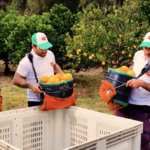Uruguay citrus season benefits from new plantations

Uruguay’s citrus harvest has begun with strong growth expectations. The industry is forecasting 25-30% volume growth, depending on the variety, in large part due to favorable weather and more acreage.
Marta Bentancur, a consultant for the Union of Fruit Producers and Exporters of Uruguay (Upefruy), told FreshFruitPortal.com that initial estimates project 86,000 tons in citrus exports, compared to 68,000 in 2023.
The fruit coloring has been coming in well, producers say, and new plantations have begun reaching their full potential. Although rainy weather should result in better fruit size, it could also impact harvest and handling.
Bentancur said, while it’s too early to confidently estimate orange volume, the sector expects 6,000 more tons of exports than in 2023, growing to 32,000.
Mandarin outlook
The fruit expected to experience the greatest increase is the mandarin, due to the growth in acreage. That category should grow by 10,000 tons to 45,000 this season.
Uruguay ranks as the fifth largest supplier of mandarin oranges to the United States with 6.4% of the market and an average volume of 50.4 million pounds, nearly 23,000 tons, sent to that market.
Meanwhile, the top U.S. mandarin supplier, Chile, is facing a decline in production this season. Chile is forecasting mandarin exports to all destinations of 160,000 tons, a decrease of 9% compared to the previous period.
Lemon outlook
For Uruguayan lemons, the market situation should improve compared to previous years with an export estimate of 10,000 tons.
“Lemons are going through a difficult time, but improved quality is being exported and to markets that demand our fruit,” Bentancur said. “We hope that this year we can improve our offer at competitive prices.”
Although Uruguay is a smaller supplier compared to its main competitors, Bentancur said, "there is very notable demand for our fruit due to quality and supply."
Uruguay’s main export markets are the United States, Europe and the Middle East. Asia has proven difficult, Bentancur said, due to the high logistical costs.







































